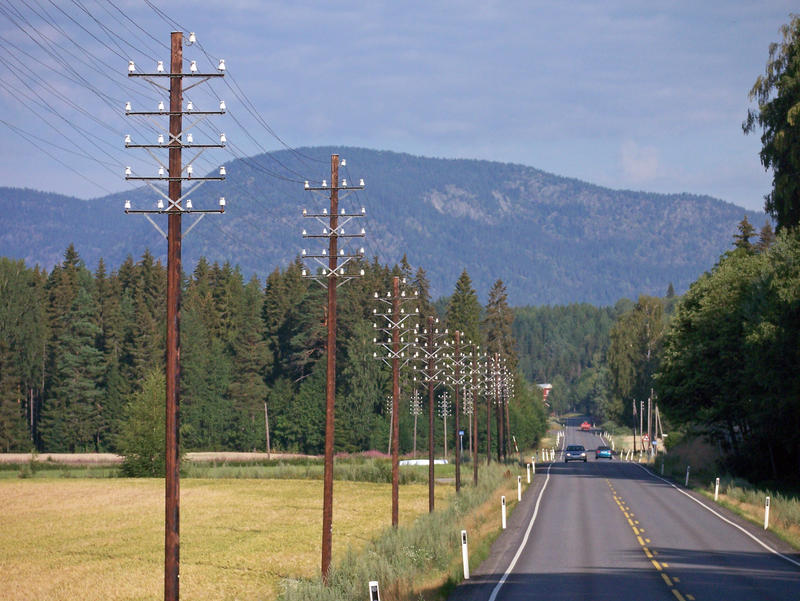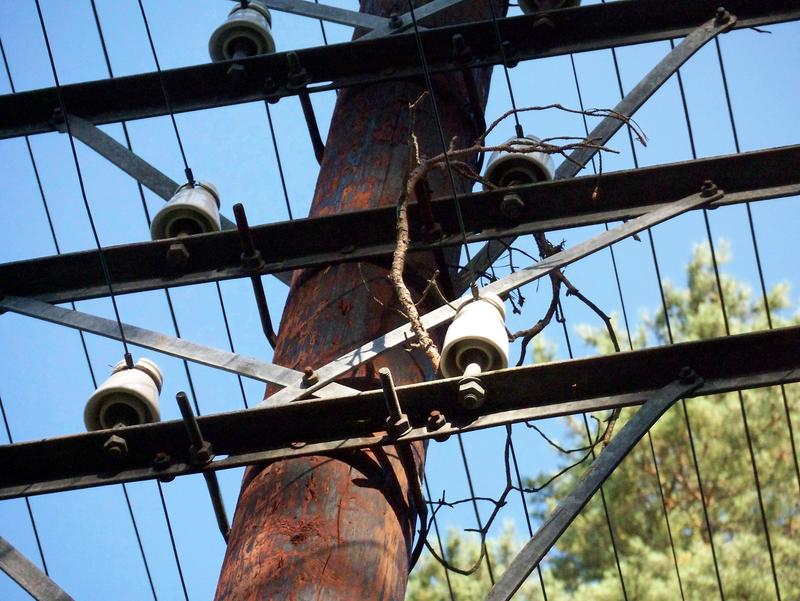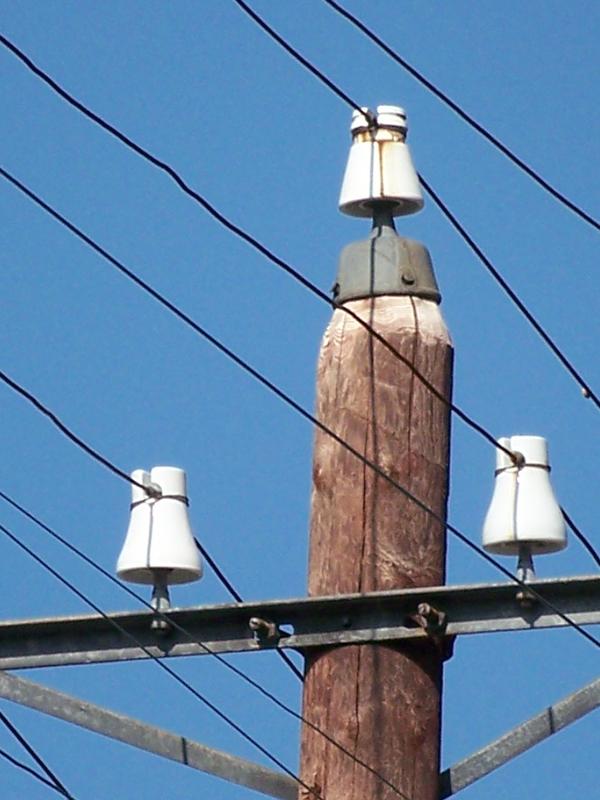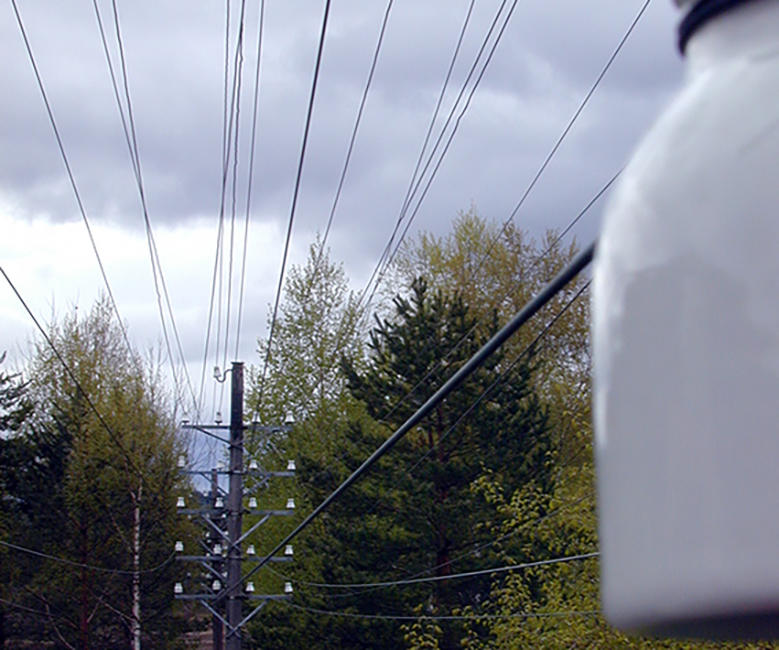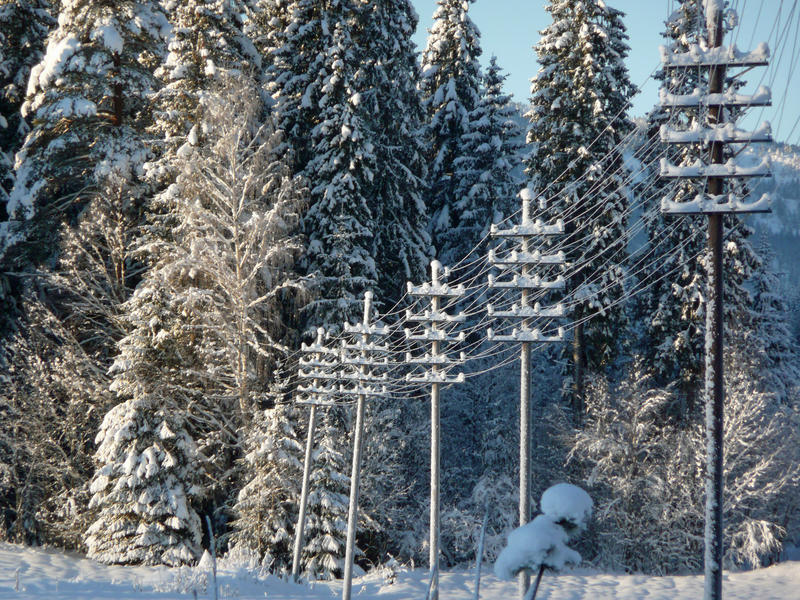-
Protected line course across Bamblesletta Telemuseet
For some it’s hard to imagine that there can be anything special about telephone poles – until you have driven across Bamlesletta in Notodden. Tall and beautiful, the historic timber poles reach up through the cultural landscape, and form a majestic line between the road and the fields. This is the last remaining stretch of the national telephone line between Kristiania and Bergen, and the oldest preserved line course in Norway. It is the upper part of the poles that’s making it difficult to stay on the road as you’re driving along in 80 kilometres per hour. Viewed through modern eyes, early telecom technology bears the likeness of gigantic jewellery: Four, iron cross bars, each carrying four small, white porcelain hats, come together to form a crown-like construction. Between each of the 120 protected poles, from crown to crown, 17 wires stretch. 17 swaying communicational threads which once were what tied Norway together.
-
Details of protected line course Telemuseet
“Hello, Bergen?”
Obviously, it wasn’t for aesthetic reasons that the government granted 80.500 NOK for the completion of the line course through Telemark in 1896. Finally there would be a telegraph- and a national telephone line between Eastern- and Western Norway. The work took four and a half years, but on the 1 November 1900, the population of Bergen could place a call to Kristiania. In those days, a call cost one NOK for three minutes, that’s equivalent to 61 NOK per minute today, and over one third of a day’s pay in 1900.
-The telephone arriving did not mean that the telegraph was closed down, says specialist adviser for Telenor Cultural Heritage, Laila Andersen.
-They went hand in hand for a long time.
The telegraph wire was attached to the uppermost insulator, while the telephone wires ran underneath, assembled on the “revolve-principle”: The assembly order would revolve from pole to pole, in this way avoiding the formation of magnetic fields which could disturb the signal down the line. The telephone wires were originally made by copper, but after repeated thefts, Telenor chose to replace most of them with less lucrative (and tempting) iron wire in 2010.
-
"Emperor Wilhelm's hat" Telemuseet
Imperial
It’s the white insulators which lend the line courses their characteristic, almost regal look. Fittingly, the tops of the parts the insulators are attached to, bear the nickname “Emperor Wilhelm’s hat,” named after the German Emperors pointy military helmet. Known for his peculiar headwear, the Emperor was an original among nobility, and he left deep impressions in Norwegian telecom history. Among other things, he donated a Telefunken transmitter facilitating the wireless connection between Røst and Sørvågen in Lofoten in 1906.
-Emperor Wilhelm loved Lofoten and Norway, tells Laila Andersen, specialist advisor for Telenor Cultural Heritage.
-He visited Norway numerous times with his ship.
At the fitter’s base at Miland in Telemark, they have boxes and boxes of porcelain hats
in stock, but there are still challenges connected to the future maintenance of the line. The protection order posed by the Directorate for Cultural Heritage in 1996, states that the line course is to be kept in good order and that as much as possible is to stay original. Few people today have the special competence needed to do this job, so Telenor Cultural Heritage is working on keeping the old skills and techniques involved in rigging and splicing bare wire alive.
- 1/1
Protected line course Telemuseet
-
Line course with snow Telemuseet
Lines across Norway
Let’s take one step aside, away from the protected line course and the route it follows along the roads, through the woods and across fields in Telemark. Let’s take a look at what these poles and the wire that connects them represent. The end of the 1800s saw a nationwide construction of a long distance network for telephony in Norway. In 1870, more or less the entire kingdom was connected. Stippled telephone lines criss-crossed the map of Norway. Down into valleys, across fjords and over high mountains, poles were erected and fitted with heavy, iron wire. The men working here were called “graffare” or “telerallare,” and their effort was crucial to the further development of the nation. If Harald Fairhair was the one to gather Norway in to one kingdom, it was these men that got us to communicate.
The telegraph was particularly important to Norway due to the country’s length and impassable nature. A message that would earlier have taken days, weeks and months to deliver, could now get to its destination in a few seconds. It was a revolution, particularly to the press and to business. The growth in the fishing industry, for instance, is an example of how the telegraph safeguarded business in the rural areas, and promoted welfare. The industrial revolution was closely intertwined with the development of the telegraph network. Like in the rest of Europe, this was a time of great change in Norway, prosperity increased and the population grew. Ever larger parts of society were industrialised, and thanks to the telegraph, orders could be made and demands reported, much faster than with the postal service. In 1865 almost a third of what was produced in Norway was exported.
The poles in Telemark are, in other words, not just a characteristic jewel in the cultural landscape, or just something to cast a glance at as you streak past on the E134, they are milestones in the tele-technical development, and symbolic bearers of the conversations and the communication that led Norway into the future.
